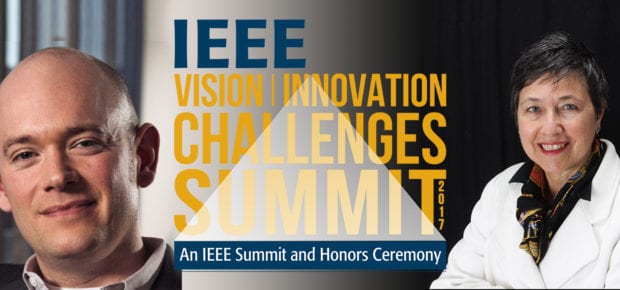May 1, 2017
AI, Smart Cities, Big Data and More…
Brian David Johnson, world renowned Futurist, and Monique Morrow, chief technology strategist, are the masters of ceremony for the 2017 IEEE VIC Summit.
What do you see as the key technology developments that are coming in 2017?
Brian: Over the next few years a constellation of technologies will be coming together to bring about sweeping change to industries. AI, smart cities, big data as well as autonomy on land, sea and air – are poised to converge to transform markets and our definition of labor.
Monique: I wrote about this in a blog post –I will preface with the observation that technological change is more exponential than ever before.
The top 10 developments I see are:
- AR: Digital devices will continue to build on top of our real world to offer enhanced experiences. Think mobile apps for banks that you can hold up and find the nearest branch to you. Or video content that depends on where you are.
- VR: Imagine headsets everywhere, as much a part of the digital experience as a cell phone case. We may not have total saturation by the end of 2017, but you can bet that this year will be part of a major transition toward ubiquitous VR.
- Blockchain: I have written elsewhere about the promise of blockchain enterprises, which bring increased accountability to global systems. The push for stability and transparency will continue to bring blockchain about.
- Security: This year, privacy and data protection will remain a primary concern for industries, consumers, and governments. We will all have to think carefully about each decision to share or purchase we make. As Shelly Palmer writes about Alexa, the Amazon Echo’s personality, our agency as individuals is entangled with what we choose to disclose
- Women-Tech and
- 3-D Medicine: Number five and six go together because women in technology build things that make the world a better place. In 2016, Plum Alley Investments, the group that funds female innovation, invested in Epi-Bone, a biomedical tech startup that uses 3D printing to grow human bones. More of these gender-conscious investments and medically innovative moves are sure to be made in 2017.
- Connected Car: This year will usher in the smart car. It’s all about personalized driving, automated safety, and surrounding car engagement. For this year’s Connected Car at the Consumer Electronics Showcase Microsoft is promising an integrated and cloud-enhanced driving experience.
- Multigenerational Teaming: As people live longer, and skills become more specialized, look to see collaboration among different age groups. Is it proven that diverse teams can solve problems better, and to tackle issues such as climate change or the digital divide, we are going to need everyone?
- Interdisciplinary Skills for 21st Century: We’re not quite at 2020, but this graphic from Scott Dockweiler explains how the skills of the future are multidisciplinary. To succeed this century, we must be adaptive, critical thinkers who can process information from a variety of backgrounds.
- Image-Based Culture: There was no slowing down of the Instagram and meme obsessions during 2016. 2017 will be another year dominated by the visual whether it be through social platforms, smart advertising, or in multimedia content How are AI and AR being used at an enterprise level? Brian: Both AI and AR have largely been unfulfilled promises to enterprise. More science fiction than fact, few people have begun to apply either technology with a meaningful ROI. If there was compelling business case you would see them used more widely. With that said, both could be hugely impactful to businesses. AR’s near-term gains can be seen in training and in information assistance with employees. The blend of the physical and the digital makes for a fertile ground to increase employee performance and efficiency. AI is starting to come into its own – I’ve called this “industrial grade AI” right now people are experimenting with medical, marketing and visual recognition applications for AI but even Watson is struggling to find that elusive ROI.
Monique: AR’s coming impact on devices and entertainment has been extensively discussed. The gadgets of the future will expand capabilities for providing a better consumer experience. Of course, these developments are important. But I want to discuss here another aspect of AR that has not received as much attention. I want to talk about how AR, and AI along with it, can create significant value at the enterprise level.There are a number of ways that AR can add value to a company. Caterpillar, the American company that engineers machinery among other things, is helping employees use AR for equipment repair and maintenance. Through an iPad and AR software, field workers have a greatly enhanced range of solutions to problems. This decreases the amount of time a machine may be out of commission, and in some cases could entirely eliminate the need for additional service visits.Processes in the office, such as hiring, can be greatly improved through artificial intelligence. Just look at Unitive, the software company developed by computer scientist and cyber security expert Laura Mather. The Unitive software mitigates unconscious bias from hiring to ensure the most qualified candidate is chosen for a job, despite gender, ethnicity, race, or even favorite sports team. (“Yes, this really happens”, says Unitive’s website in regard to sports.)With AR and AI, there are potentials for abuse. One of the main issues with newer hard and softwares is privacy, which can have far-reaching consequences when people are unaware that their data is being shared or used in ways without their knowing approval. The IEEE Global Initiative for Ethical Considerations in Artificial Intelligence and Autonomous Systems is one such program to try to curb these potential abuses. This initiative works on “standards and solutions, certifications and codes of conduct, and consensus building for ethical implementation of intelligent technologies.” The hope here is to influence business leaders and policy makers.
Applying the benefits of enhanced reality to businesses can create ripples of value in different enterprises. In addition to making enterprise processes more efficient, AI and AR can also make workspaces more equitable, and less vulnerable to expensive legal challenge, through practices like hiring. I encourage all forward-thinking professionals in my network to think of ways they can bring AR and AI into their enterprises, keeping the important research of groups like AI Now and the IEEE Initiative in mind.
What are issues are companies who are adopting this technology facing, and how can they overcome them?
Brian: Both were technologies in search of a problem. They worked great for demos and laboratory experiments but until a path to investment becomes clear there will be hurdles.There needs to be increased partnerships with the enterprise and explore the real world applications of these technologies.
Monique: There are several issues companies struggle with when adopting these sets of technologies, e.g binding to their core business strategy in the form of unlocking value for customers and an ecosystem of players. The rapid pace of technological change can result in enterprises maintaining a defense strategy when it comes to their current business. There is a fine balance between keeping the current business running and evolving to new competitive business models. Technologies are only tools in this digitalization process.
What are the social implications of AI?
Brian: When industrial grade AI is applied to business with true effect it will have a massive effect on the labor force. AI will hallow out the center of the work force, redefining the very definition of work and how the market values labor.
Monique: It is critical that technologists are trained in ethics so they can build and design technology that promotes and inspires our collective empathy, our work, ourselves and our society as a whole. Here are a few examples of how and why ethically-minded technology is so important today and into the future.
Virtual Reality As A Means To Experience Others’ Existences
Right now for many of us, when we think about VR we think about it generally in terms of advancing media consumption, from games and sports to politics and movies. Virtual reality can certainly tell a richer story because you don’t simply watch it, you experience it.Therefore, VR represents a breakthrough way that people can experience not simply media in new ways, but others’ unique lives. Imagine an advanced virtual world, like an evolved Second Life that requires a headset, where there is a stable of AI-animated avatars that behave in a way that statistically reflected the population. For example, a man could be a woman, a police officer could be a recent immigrant, a person could have a physical disability.
Imagine what you would learn through this exercise of experiencing other people’s lives and conditions? This could become part of our standard education process. If put into practice, this could significantly improve our collective ability to identify with people who have very different experiences. In today’s political climate, this has never seemed more important.
Exposure Therapy As A Means to Change Psychotherapy
Advanced VR can also work to change the brain’s plasticity in ways that have never previously been possible. What does this mean? From relieving simple fears of animals or heights, to helping the debilitating effects of PTSD, retraining the brain to process stimuli differently can be powerful.This type of treatment can also work to prepare soldiers to go to war or train employees to deal with intensive work environments or field operations. There are clear positives to how this can be useful, but there are also important questions to be asked about harnessing the ability to make the brain process events differently. Is it okay to train a person’s brain to make them comfortable doing something that, under normal circumstances, makes them uncomfortable? Ethical consideration about how this technology is designed and built is paramount.
Virtual Agents Who Take Actions On Our Behalf
Imagine the future where you are able to see your doctor when you want, where you want, without the hassle and wait of today’s healthcare system. In the future, a virtual agent imbued with AI characteristics could be the solution. Instead of seeing your actual doctor, you are seeing her or his virtual agent that has the ability to develop a long-term, human-like relationship but is actually a stand-in, a complete software concoction. This software concoction isn’t a person, but is a constantly shifting team of experts whose opinions are reconciled by artificial intelligence. This virtual agent could become typical in areas like healthcare that require both deep and broad expertise.This brings up critical ethical considerations, how would you teach such an agent? Who would be ultimately responsible for the decisions these committees masquerading as individuals might make?
The Importance Of Seeing Beyond Our Perspective
For the next generation, a large part of day-to-day life will fall under the control of software. From going to work, to socializing, to finanical planning, to cleaning the house, to tracking health, to going shopping and being entertained, these tasks will be modeled in software so as to allow automatic interoperability and human interaction with real-time content that is pulled instantly.Yes, this will be convenient, but it will also create ethical problems. Without interjection, this will naturally rush us into a software-meditated world in which we see, hear and experience only what we want to see, hear and experience. A “well designed” product will eliminate the noise and just provide us with our “echo chamber” of the opinions we agree with, the music we liked in the past, the food we like to eat, while only being exposed to a sliver of new content based on our previous likes and interests. You see this already in your Facebook feed, for example. This creates an illusion of a comfort, but it fuels a homogeneous world. With inevitable commercial pressure to give consumers what they want, this will be the natural progression of technology.
Software perfectly tailored to manage our specific needs, likes and everyday tasks will eliminate outside obstacles or friction, which can hurt us. Humans do not grow when surrounded only by those who agree with them. A thoughtful quote, “the blessing is outside of your comfort zone,” encapsules this. Our comfort zone, what we know we like, is comfortable, but it is not the place where we grow. Humans grow when confronted by events, people and experiences they would never choose and, honestly, might actively avoid if they could.
But the magic and inspiration happens outside of the comfort zone. A surprisingly important piece of our lives hinges on the unpredictable, the serendipitous, the random, the uncomfortable.
Now, the big question, How do you program that? How could an AI-system make such decisions? Is there any commercial motivation to make software-guided experiences less pleasant? When everything has been systematized, when does chance occur? When the randomness of life is removed to make things more pleasant, more convenient, easier—what is the human cost?
These are big concepts, and big questions, and I hope it helps to illustrate the deep importance of initiatives like IEEE’s Ethics in Autonomous Systems. So much more work is needed in these areas, and I am so excited to be a part of it.





 Meaningful Momentum or Running in Place?
Meaningful Momentum or Running in Place? AI Through Our Ages
AI Through Our Ages Liquid Infrastructure: Our Planet's Most Precious Resource
Liquid Infrastructure: Our Planet's Most Precious Resource The Impact of Technology in 2025
The Impact of Technology in 2025 Quantum and AI: Safeguards or Threats to Cybersecurity?
Quantum and AI: Safeguards or Threats to Cybersecurity? Why AI Can't Live Without Us
Why AI Can't Live Without Us Bits, Bytes, Buildings and Bridges: Digital-Driven Infrastructure
Bits, Bytes, Buildings and Bridges: Digital-Driven Infrastructure Impact of Technology in 2024
Impact of Technology in 2024 Emerging AI Cybersecurity Challenges and Solutions
Emerging AI Cybersecurity Challenges and Solutions The Skies are Unlimited
The Skies are Unlimited Smart Cities 2030: How Tech is Reshaping Urbanscapes
Smart Cities 2030: How Tech is Reshaping Urbanscapes Impact of Technology 2023
Impact of Technology 2023 Cybersecurity for Life-Changing Innovations
Cybersecurity for Life-Changing Innovations Smarter Wearables Healthier Life
Smarter Wearables Healthier Life Infrastructure In Motion
Infrastructure In Motion The Impact of Tech in 2022 and Beyond
The Impact of Tech in 2022 and Beyond Cybersecurity, Technology and Protecting Our World
Cybersecurity, Technology and Protecting Our World How Technology Helps us Understand Our Health and Wellness
How Technology Helps us Understand Our Health and Wellness The Resilience of Humanity
The Resilience of Humanity Harnessing and Sustaining our Natural Resources
Harnessing and Sustaining our Natural Resources Creating Healthy Spaces Through Technology
Creating Healthy Spaces Through Technology Exceptional Infrastructure Challenges, Technology and Humanity
Exceptional Infrastructure Challenges, Technology and Humanity The Global Impact of IEEE's 802 Standards
The Global Impact of IEEE's 802 Standards Scenes of our Cyber Lives: The Security Threats and Technology Solutions Protecting Us
Scenes of our Cyber Lives: The Security Threats and Technology Solutions Protecting Us How Millennial Parents are Embracing Health and Wellness Technologies for Their Generation Alpha Kids
How Millennial Parents are Embracing Health and Wellness Technologies for Their Generation Alpha Kids Space Exploration, Technology and Our Lives
Space Exploration, Technology and Our Lives Global Innovation and the Environment
Global Innovation and the Environment How Technology, Privacy and Security are Changing Each Other (And Us)
How Technology, Privacy and Security are Changing Each Other (And Us) Find us in booth 31506, LVCC South Hall 3 and experience the Technology Moon Walk
Find us in booth 31506, LVCC South Hall 3 and experience the Technology Moon Walk Virtual and Mixed Reality
Virtual and Mixed Reality How Robots are Improving our Health
How Robots are Improving our Health IEEE Experts and the Robots They are Teaching
IEEE Experts and the Robots They are Teaching See how millennial parents around the world see AI impacting the lives of their tech-infused offspring
See how millennial parents around the world see AI impacting the lives of their tech-infused offspring Take the journey from farm to table and learn how IoT will help us reach the rising demand for food production
Take the journey from farm to table and learn how IoT will help us reach the rising demand for food production Watch technical experts discuss the latest cyber threats
Watch technical experts discuss the latest cyber threats Explore how researchers, teachers, explorers, healthcare and medical professionals use immersive technologies
Explore how researchers, teachers, explorers, healthcare and medical professionals use immersive technologies Follow the timeline to see how Generation AI will be impacted by technology
Follow the timeline to see how Generation AI will be impacted by technology Learn how your IoT data can be used by experiencing a day in a connected life
Learn how your IoT data can be used by experiencing a day in a connected life Listen to technical experts discuss the biggest security threats today
Listen to technical experts discuss the biggest security threats today See how tech has influenced and evolved with the Games
See how tech has influenced and evolved with the Games Enter our virtual home to explore the IoT (Internet of Things) technologies
Enter our virtual home to explore the IoT (Internet of Things) technologies Explore an interactive map showcasing exciting innovations in robotics
Explore an interactive map showcasing exciting innovations in robotics Interactively explore A.I. in recent Hollywood movies
Interactively explore A.I. in recent Hollywood movies Get immersed in technologies that will improve patients' lives
Get immersed in technologies that will improve patients' lives